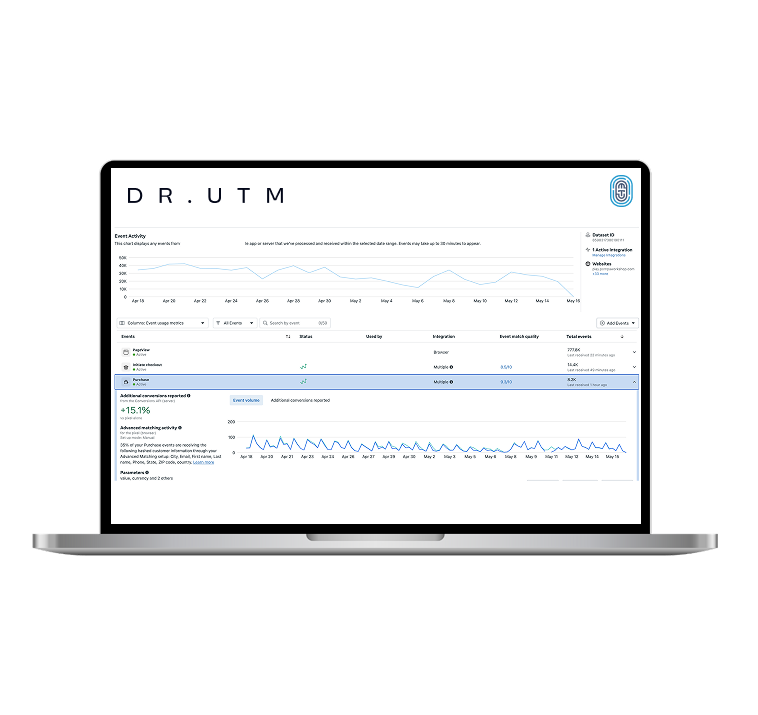You’ve got the team.
You’ve got the funnel.
You’ve got the spend.
So why do your Meta campaigns feel like they’re running on emotion?
If you’re spending six figures a month on paid media, chances are you’ve felt it:
- ROAS suddenly collapses without warning
- Cost per lead spikes for no clear reason
- The same winning creative stops converting
- Your best audiences stop scaling
- “Meta’s just moody” becomes your team’s default excuse
But here’s the truth…
Unless you address what’s actually behind that volatility, scaling will always feel like a guessing game—no matter how dialed-in your creative, funnel, or media buying.
🎯 The Myth of the “Moody Platform”
We’ve been conditioned to think Meta’s performance swings are just part of the game.
But behind the volatility is a much simpler, much scarier truth:
The platform is working off incomplete, inaccurate, or broken data.
It’s not random. It’s not emotional.
It’s a machine learning model making decisions based on what you feed it.
If your tracking is off—even slightly—Meta’s optimization engine can’t do its job.
And when that happens at the $100K+ level?
You bleed money fast.
🧨 Where Things Started Breaking (and Why It’s Getting Worse)
Let’s rewind:
- iOS 14 decimated pixel tracking
- iOS 17 stripped even more data (including UTMs)
- Privacy regulations (GDPR, CCPA, etc.) made basic tools legally risky
- And the platforms themselves? More reliant than ever on clean conversion feedback
The result?
You went from feeding Meta clear, event-rich conversion paths…
to feeding it noise. Or worse, nothing at all.
And that’s what creates the illusion of “moodiness.”
🧠 Why It’s Not Your Ads (Even If It Looks Like It)
Here’s what’s wild:
A campaign that fails with incomplete signals…
could scale when Meta actually gets the data it needs to optimize.
Creative doesn’t perform in a vacuum.
It performs in the context of the data that powers the algorithm.
If Meta can’t connect the dots between:
- Who clicked
- What they did
- When they converted
- How they moved through your funnel
Then it can’t optimize, can’t scale, and can’t replicate success.
So you start throwing more at creative. More at budget. More at audience testing.
When in reality, what you need is to feed the algorithm better data.
🧩 What Six-Figure+ Advertisers Actually Need to Fix This
If you’re operating at scale, the fix isn’t creative. It’s the system behind your signals.
Here’s what your tracking system should really do:
✅ Capture the entire user journey, across channels and devices
✅ Send verified, conversion-level signals to Meta (not just click events)
✅ Be custom-built to your unique funnel and offer structure
✅ Stay fully compliant with GDPR, CCPA, and platform terms
✅ Work in real-time, not after-the-fact dashboards
This isn’t about attribution.
It’s about feeding the algorithm exactly what it needs to win.
🔧 How Dr. UTM Fixes the Mood Swings—By Fixing the Signals
Dr. UTM isn’t a pixel, a plugin, or a reporting tool.
It’s a custom-built performance data system that:
- Captures full-funnel behavior across platforms
- Cleans, enriches, and routes conversion signals directly to Meta’s API
- Matches signals to platform logic—so Meta knows what to optimize
- Works with any funnel, CRM, or lead flow
- Is 100% white-hat and privacy compliant out of the box
With Dr. UTM, you don’t just get attribution—you get control.
Control over what the algorithm sees.
Control over how your campaigns scale.
The Outcome? Predictability.
One brand came in spending $300K+ a month.
Their ROAS swung from 0.9 to 2.3 week over week—despite consistent inputs.
After implementing Dr. UTM, their signal path was rebuilt from the ground up.
ROAS stabilized, volatility disappeared, and they finally scaled past the plateau.
The problem wasn’t the media buying.
It was the platform’s understanding of what was working.
Final Take: The Platform Isn’t Guessing Because It Wants To
Meta’s not unpredictable.
It’s just starved for clarity.
If you’re sending incomplete, generic, or delayed signals, you’re asking it to optimize blindfolded.
And at six figures a month?
That’s not a mood swing—it’s a million-dollar leak.
✅ Ready to Fix the Real Problem?
Dr. UTM helps high-spend advertisers take back control—by fixing the signals that fuel the platform.
Every system is custom-built to your funnel, tech stack, and offer strategy.
👉 [Apply Now] to stop guessing, start scaling, and make Meta perform the way it should.









